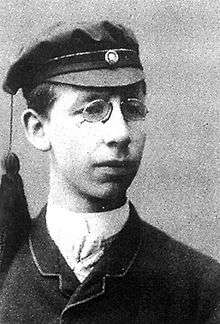Johan Vaaler


Johan Vaaler (March 15, 1866 – March 14, 1910) was a Norwegian inventor and patent clerk, from 1892 office manager of Bryns Patentkontor in Kristiania.[1] He has often erroneously been identified with the invention of the common paper clip, known to all office employees for more than a hundred years. He was born in Aurskog as the son of a farmer, and died in Kristiania.
Vaaler designed a kind of paper clip in 1899 and applied for a German patent on November 12 of that year. It was granted on June 6, 1901 (DE 121067).[2] He also filed an application for a United States patent on January 9, 1901. The U.S. patent was granted on June 4, 1901.[3]
Unknown to Vaaler, a more functional and practical paper clip was already in production by the British "Gem Manufacturing Company Ltd", but not yet marketed in Norway. His design was less perfect because it lacked the two full loops of the wire. Vaaler probably succeeded in having his design patented abroad, despite the existence of a better product, because patent authorities at that time were quite liberal and rewarded any marginal modification of earlier inventions.[4] Several types of paper clips had been patented in the United States since 1867,[5] but the "Gem" type was not then (and has never been) patented. As an employee of Bryns patent office in Kristiania, Vaaler was familiar with patent legislation and procedures in Norway. His reasons for applying abroad are unknown, but it is possible that he had an exaggerated confidence in his invention and saw the need to secure the commercial rights internationally. Also, he may have been aware that Norwegian inventors would meet difficulties on the small home market. Quite soon he must have had the disappointment of his life when he was confronted by the "Gem", which was probably introduced in Norway during his own lifetime.[6] He is not known to have tried to contact potential manufacturers in Norway or abroad, and this lack of initiative seems to confirm that he soon learned that a superior clip already existed. His patent was allowed to expire quietly, without a single one of his many proposed designs having ever been manufactured. Meanwhile, the "Gem" conquered the world, including his own country. The Norwegian fish hook manufacturer O. Mustad & Søn AS of Gjøvik has produced Gem-type paper clips since 1928.[7]
Vaaler's alleged invention of the paper clip became known in Norway after World War II and found its way into some encyclopedias.[8] Events of that war contributed greatly to the mythical status of the paper clip as a national symbol. During the resistance to the German occupation during World War II, after pins or badges bearing national symbols or the initials of exiled King Haakon VII were banned, Norwegians began to wear paper clips in their lapels as a symbol of resistance to the occupiers and local Nazi authorities. The clips were meant to denote solidarity and unity ("we are bound together"). Their symbolism was even more obvious because paper clips are called "binders" in Norwegian. Their presumed Norwegian origin was not generally known at that time, but when that widely believed story was added to the war-time experience of many patriots, it strengthened their status as national symbols.
References
- ↑ Holst, W.: "Johan Vaaler", Studentene fra 1887, Kristiania 1912
- ↑ Foss, Halvard: "Den frittstående oppfinner", Styret for det industrielle rettsvern 50 år, pp 188-195, Patentstyret, Oslo 1961, p. 190
- ↑ Petroski, Henry: The Evolution of Useful things, New York 1993, p. 61
- ↑ Petroski, Henry: "The Evolution of Artifacts", American Scientist, Volume 80, 1992, pp. 416–20
- ↑ Early Office Museum web site, unknown author, History of the Paper Clip. Consulted on July 2, 2008.
- ↑ No sources confirming this assumption have yet been found, but the "Gem" was known in Sweden early enough to make that word the generic term for any paper clip, and it is likely tohave been known in Norway at about the same time.
- ↑ Oppland Arbeiderblad 24.04.2007: "Mustad har laget binders i snart 80 år". http://www.oa.no/nyheter/article2732145.ece Consulted May 9, 2009.
- ↑ "Binders" in Aschehougs konversasjonsleksikon, Oslo 1974, Vol. 2, p. 695
Literature
- Henry Petroski, The Evolution of Useful things (1992); ISBN 0-679-74039-2 (with a history of the evolution of paper clip design)